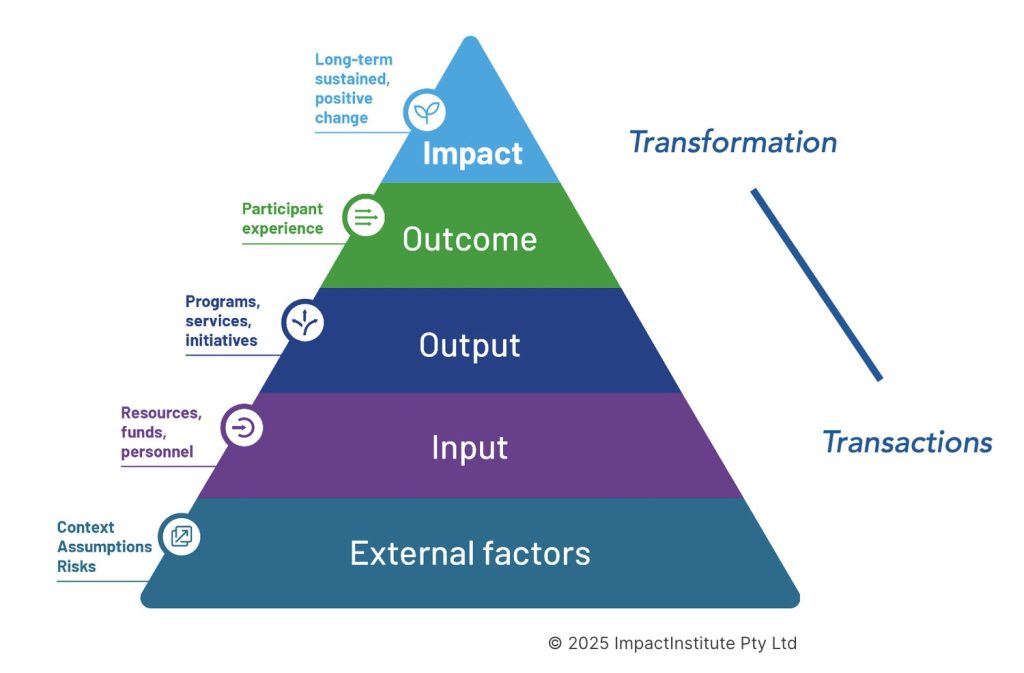Most organisations talk about purpose. Far fewer can prove their impact.
Across Australia and the Asia-Pacific, purpose-led organisations are facing a new challenge: What’s your impact?
As expectations rise, from boards to customers to regulators, leaders must move beyond mission statements and start measuring outcomes. This blog explores what social impact really means, how to define and measure it, and why the distinction between purpose-led and impact-driven organisations is more than just semantics.
What is social impact?
Social impact is the long-term, sustained, positive change achieved when an organisation’s purpose is fully realised and experienced by its stakeholders. It’s not just about doing good, it’s about doing good well, with measurable outcomes that benefit people, communities, and the environment.
Impact can be:
- Positive or negative
- Intended or unintended
- Short-term or long-term
At ImpactInstitute, we define impact as the result of acting to avoid harm, benefiting stakeholders, and contributing to solutions.
Purpose-led vs impact-driven organisations
A purpose-led organisation knows why it exists. An impact-driven organisation knows what difference it makes.
Purpose-led organisations often articulate inspiring missions, like “to build a connected future” or “to inspire the builders of tomorrow.”
Impact-driven organisations go further: they measure how well that purpose translates into real-world change.
Key differences:
- Purpose is aspirational; impact is evidential.
- Purpose is foundational; impact is experienced—by stakeholders, communities, and staff.
- Purpose is static; impact evolves with data and feedback.
Why impact matters more than ever
Today’s leaders face rising expectations, from boards, investors, regulators, and communities. ESG frameworks, social movements, and post-COVID realities have made impact a strategic imperative.
Without a clear impact strategy, organisations risk:
- Impact washing (claiming impact without evidence)
- Loss of trust with stakeholders
- Missed opportunities for growth and innovation
How to measure impact
Impact measurement is a journey—from inputs to outcomes to long-term change. ImpactInstitute’s Impact Journey Framework helps organisations track this progression:
Stages of the journey:
- Inputs: Resources like time, money, people, and tech
- Outputs: Activities and services delivered
- Outcomes: Short- to medium-term experiences of stakeholders
- Impact: Sustained, positive change beyond the program or service
Measurement tools include:
- Surveys, interviews, focus groups
- Comparative analysis with baseline data
- Economic analyses (SROI, CBA, CEA)

What’s your impact?
Here are five questions every leader should ask:
- Is our purpose being experienced by our stakeholders?
- Have we defined the impact we want to achieve?
- Are we measuring that impact consistently?
- Does our data inform program development and storytelling?
- Are we building a sustainable organisation that thrives long-term?
Impact isn’t a destination, it’s a discipline. And it starts with asking the right questions.
In summary
Social impact isn’t a buzzword, it’s a measurable outcome. For purpose-led organisations, the next step is clear: move from intention to evidence. Whether you’re shaping strategy, telling your brand story, or designing events that matter, impact must be front and centre.
The good news? You don’t have to wait. Start small. Start now. And start asking: What’s your impact?
Ready to move from purpose to impact?
Explore how ImpactInstitute can help you define, measure, and communicate your impact – across strategy, storytelling, and events.
👉 Contact us to start your impact journey.
Written by: Rian Newman, Senior Account Director, ImpactInstitute
For more information visit: Impact Advisory
